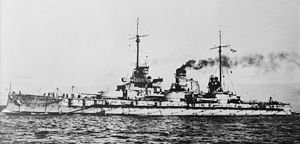SMS Westfalen

SMS Westfalen
|
|
| History | |
|---|---|
|
|
|
| Namesake: | Westphalia |
| Builder: | AG Weser, Bremen |
| Laid down: | 12 August 1907 |
| Launched: | 1 July 1908 |
| Commissioned: | 16 November 1909 |
| Fate: | Scrapped 1924 |
| General characteristics | |
| Class and type: | Nassau-class battleship |
| Displacement: |
|
| Length: | 146.1 m (479 ft 4 in) |
| Beam: | 26.9 m (88 ft 3 in) |
| Draft: | 8.9 m (29 ft 2 in) |
| Propulsion: |
|
| Speed: |
|
| Range: | At 10 knots (19 km/h; 12 mph): 8,380 nmi (15,520 km; 9,640 mi) |
| Boats & landing craft carried: |
10 |
| Complement: |
|
| Armament: |
|
| Armor: |
|
| Notes: |
|
SMS Westfalen was one of the Nassau-class battleships, the first four dreadnoughts built for the German Imperial Navy. Westfalen was laid down at AG Weser in Bremen on 12 August 1907, launched nearly a year later on 1 July 1908, and commissioned into the High Seas Fleet on 16 November 1909. The ship was equipped with a main battery of twelve 28 cm (11 in) guns in six twin turrets in an unusual hexagonal arrangement.
The ship served with her sister ships for the majority of World War I, seeing extensive service in the North Sea, where she took part in several fleet sorties. These culminated in the Battle of Jutland on 31 May – 1 June 1916, where Westfalen was heavily engaged in night-fighting against British light forces. Westfalen led the German line for much of the evening and into the following day, until the fleet reached Wilhelmshaven. On another fleet advance in August 1916, the ship was damaged by a torpedo from a British submarine.
Westfalen also conducted several deployments to the Baltic Sea against the Russian Navy. The first of these was during the Battle of the Gulf of Riga, where Westfalen supported a German naval assault on the gulf. Westfalen was sent back to the Baltic in 1918 to support the White Finns in the Finnish Civil War. The ship remained in Germany while the majority of the fleet was interned in Scapa Flow after the end of the war. In 1919, following the scuttling of the German fleet in Scapa Flow, Westfalen was ceded to the Allies as a replacement for the ships that had been sunk. She was then sent to ship-breakers in England, who broke the ship up for scrap by 1924.
...
Wikipedia
